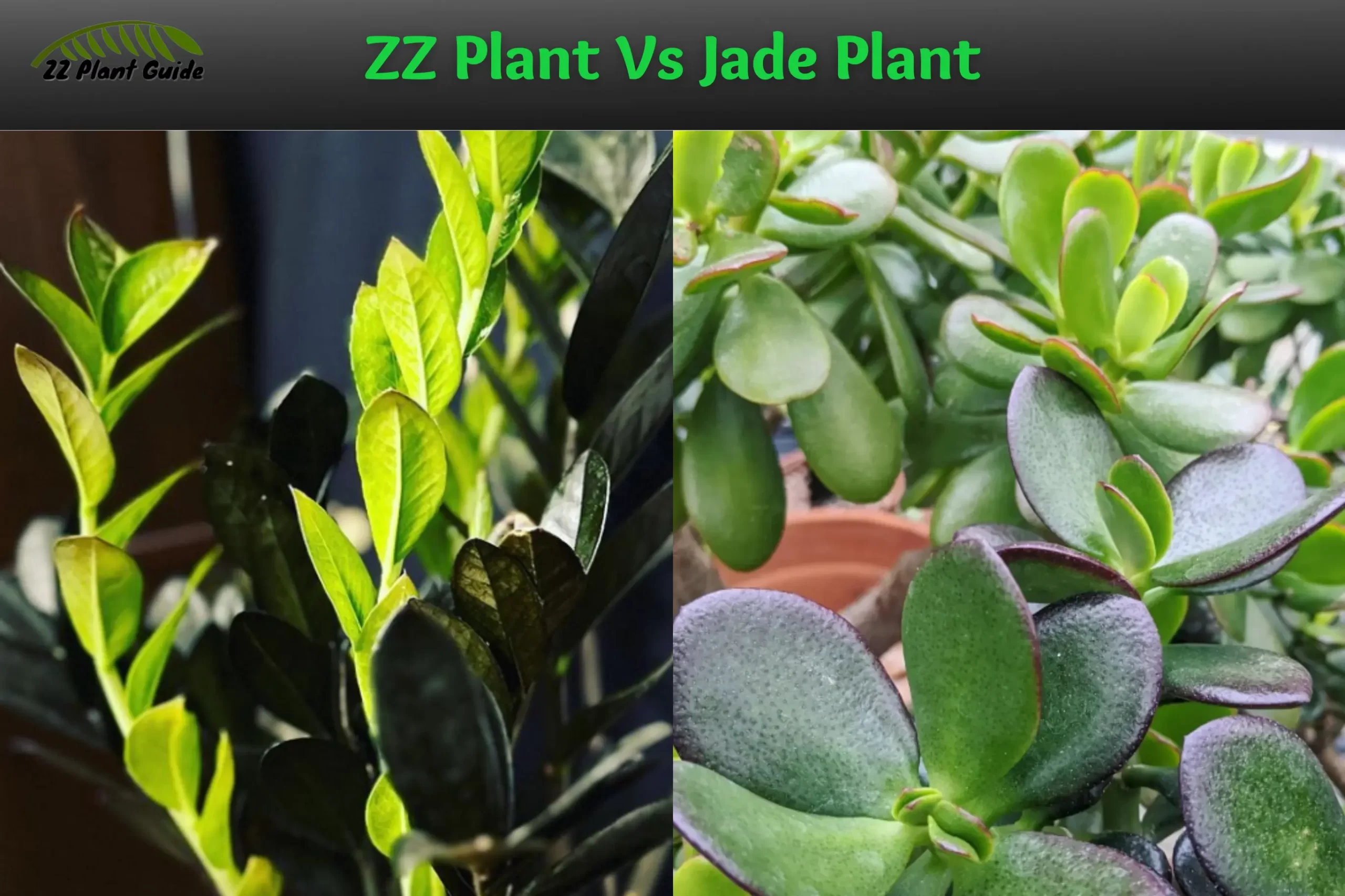Are you torn between the ZZ plant (Zamioculcas zamiifolia) and the Jade plant (Crassula ovata)? Well, then we’re going to get to the root of the matter (pun intended) in our epic plant showdown.
We’re talking ZZ vs. Jade, head-to-head, leaf-to-leaf, and everything in between. Get ready to rumble! 🌿
ZZ Plant Vs Jade Plant
Their Hometowns and Backstories
ZZ Plant:
Hailing from the tropical regions of Eastern Africa, the ZZ plant is known for its glossy leaves and ability to withstand neglect. It’s like the superhero of the plant world – always bouncing back after a dry spell.
Jade Plant:
Coming from the other corner, we have the Jade plant, a native of South Africa. This tough cookie is a succulent and is known for its chunky leaves and money-attracting superpowers (or so they say).
Their Looks and Styles
ZZ Plant:
The ZZ plant sports shiny, dark green leaves that grow on thick, vertical stems. They give off major “I’m a low-maintenance, gorgeous houseplant” vibes.
Jade Plant:
On the other side, the Jade plant is all about that chunky, fleshy leaf life. With its cute, rounded leaves and woody stem, it’s like the chubby-cheeked baby of the plant world.
How They Roll (aka Growth Habits)
ZZ Plant:
The ZZ plant grows slowly but steadily. If you’re looking for a buddy that won’t outgrow its pot too fast, then the ZZ plant is your guy!
Jade Plant:
The Jade plant may take a while to get going, but once it’s established, it can grow into a sizeable, branching shrub. If you’re all about patience and watching your green baby grow, then this one’s for you.
Light ’em Up! (Light Requirements)
ZZ Plant:
The ZZ plant is a champion when it comes to low-light situations. It’s like the plant version of a vampire, thriving in the shadows. But don’t worry, a bit of indirect sunlight won’t hurt it either.
Jade Plant:
The Jade plant is all about that bright, indirect light life. It’s like a little sun worshipper, but remember, too much direct sunlight can burn its cute, chubby leaves.
The Thirst is Real (Watering Needs)
ZZ Plant:
The ZZ plant is a total champ at handling droughts. If you’re the forgetful type (no judgment here), then this resilient buddy is perfect for you. Just give it a drink when the soil feels dry, and it’ll be a happy camper.
Jade Plant:
The Jade plant’s succulent nature means it can store water in its leaves. If you overwater it, it’ll be like, “Whoa, buddy! I’m good, thanks!” Just let the soil dry out between waterings, and you’re golden.
Temperature and Humidity Preferences
ZZ Plant:
This tropical warrior can handle average indoor temperatures like a pro. It doesn’t need a sauna or a winter wonderland – just keep it comfy, and it’ll thrive.
Jade Plant:
The Jade plant is pretty chill (pun intended) when it comes to temperature. It prefers cooler indoor temps but can handle a range. Just don’t let it freeze or roast, and it’ll be happy.
The Battle of the Blooms
ZZ Plant:
The ZZ plant is like, “Flowers? Who needs ’em?” While it can produce tiny, yellowish flowers, they’re rare and not really the main attraction. If you’re in it for the foliage, then the ZZ plant is your jam.
Jade Plant:
The Jade plant, on the other hand, is all about showing off when it’s feeling good. When it’s happy and well-cared for, it can produce small, white or pink, star-shaped flowers. It’s like a little firework display for your living room!
Propagation Party
ZZ Plant:
The ZZ plant is a real people-pleaser when it comes to propagation. Just cut off a leaf, stick it in some soil, and watch it grow a new plant. It’s like a little plant factory!
Jade Plant:
The Jade plant loves to share the love too. You can easily propagate it by taking a leaf or stem cutting, letting it callus over, and then placing it in well-draining soil. Before you know it, you’ll have a Jade plant army!
The Scorecard (Pros and Cons)
ZZ Plant:
Pros:
- Low-maintenance, great for beginners
- Can handle low light like a boss
- Drought-tolerant and forgiving
Cons:
- Slow grower
- Rarely blooms
Jade Plant:
Pros:
- Chubby, cute leaves (who can resist?)
- Can produce lovely flowers
- Easy to propagate
Cons:
- Needs bright, indirect light
- Sensitive to overwatering
Final Thoughts!
The battle between the ZZ plant and the Jade plant is a close one. Both plants have their strengths and quirks, but ultimately, it’s up to you to decide which one suits your personality, home, and lifestyle best.
Are you Team ZZ, the low-maintenance superhero, or Team Jade, the sun-loving, chubby-leafed charmer? Whichever you choose, you’re sure to have a delightful green companion to brighten up your space. 🌱
FAQs
Yes, both ZZ plants and Jade plants are considered toxic to pets like cats and dogs. If you have furry friends at home, make sure to place these plants out of their reach to avoid any accidents.
ZZ plants have an edge in this department. According to a NASA study, ZZ plants are effective at removing air pollutants like xylene, toluene, and benzene. While Jade plants may help improve air quality to some extent, they are not as well-known for their air-purifying abilities.
Technically, you can grow them together, but it’s not ideal. ZZ plants and Jade plants have slightly different light and watering requirements, so growing them in the same pot may make it harder to meet both plants’ needs.
Overwatering can cause root rot and other issues for both ZZ plants and Jade plants. Signs of overwatering include yellowing leaves, wilting (despite wet soil), and mushy, black roots. If you notice these symptoms, it’s time to cut back on watering and let the soil dry out before the next watering.
Both ZZ plants and Jade plants are low-maintenance when it comes to feeding. For ZZ plants fertilize once every 4-6 months using a balanced, water-soluble fertilizer. Jade plants can be fertilized every 3-4 months with a fertilizer specifically formulated for succulents. Remember, less is more – it’s better to under-fertilize than to overdo it!




